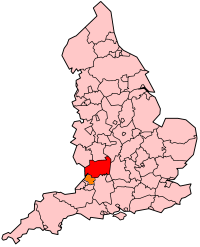Gloucestershire

| |
| Geography | |
| Status | Ceremonial & (smaller) Administrative county |
|---|---|
| Region: | South West England |
| Area - Total - Admin. council - Admin. area |
Ranked 16th 3,150 km² Ranked 17th 2,653 km² |
| Admin HQ: | Gloucester |
| ISO 3166-2: | GB-GLS |
| ONS code: | 23 |
| NUTS 3: | UKK13 |
| Demographics | |
| Population - Total (2003 est.) - Density - Admin. council - Admin. pop. |
Ranked 24th 815,263 259 / km² Ranked 21st 568,452 |
| Ethnicity: | 97.3% White |
| Politics | |
| Arms of Gloucestershire County Council Gloucestershire County Council http://www.gloscc.gov.uk/ | |
| Executive | Conservative |
| Members of Parliament | |
| Districts | |
 | |
Template:Infobox England traditional county
Gloucestershire (pronounced [ˈglɔːstɜːʃɜː]; GLOSS-ter-sher) is a county in southwest England. The county comprises part of the Cotswold Hills, part of the flat fertile valley of the River Severn, and the entire Forest of Dean.
The county town is Gloucester, and other principal towns include Cheltenham, Stroud, Cirencester, and Tewkesbury.
When considered as a ceremonial county, Gloucestershire borders the preserved county of Gwent in Wales, and in England the ceremonial counties of Herefordshire, Oxfordshire, Worcestershire, Warwickshire, and Wiltshire (including Swindon).
The official postal abbreviation is "Glos.", rather than the frequently used but erroneous "Gloucs." or "Glouc.".
Historically, Gloucestershire has also included Bristol, but this has not been considered part of Gloucestershire since Bristol became a county corporate in 1373. The area of South Gloucestershire was made part of the administrative County of Avon in 1974. Upon the abolition of Avon in 1996, it became a unitary authority, and returned to Gloucestershire for ceremonial purposes.
Towns and villages
See the list of places in Gloucestershire.
Antiquities and Other Places of interest
- Berkeley Castle, an example of a feudal stronghold.
- Forest of Dean
- Hailes Abbey
- Sudeley Castle
- Tewkesbury Abbey
- Tyndale Monument
- Wildfowl and Wetland Trust, Slimbridge
The cathedrals of Gloucester and Bristol, the magnificent abbey church of Tewkesbury, and the church of Cirencester with its great perpendicular porch, are described under their separate headings. Of the abbey of Hayles near Winchcomb, founded by Richard, earl of Cornwall, in 1246, little more than the foundations are left, but these have been excavated with great care, and interesting fragments have been brought to light.
Most of the old market towns have fine parish churches. At Deerhurst near Tewkesbury, and Cleeve near Cheltenham, there are churches of special interest on account of the pre-Norman work they retain. The Perpendicular church at Lechlade is unusually perfect; and that at Fairford was built (c. 1500), according to tradition, to contain the remarkable series of stained-glass windows which are said to have been brought from the Netherlands. These are, however, adjudged to be of English workmanship, and are one of the finest series in the country.
The great Decorated Calcot Barn is an interesting relic of the monastery of Kingswood near Tetbury. Thornbury Castle, in the same district, is a fine Tudor ruin, the pretensions of which evoked the jealousy of Cardinal Wolsey against its builder, Edward Stafford, duke of Buckingham, who was beheaded in 1521. Near Cheltenham is the fine 15th-century mansion of Southam de la Bere, of timber and stone. Memorials of the de la Bere family appear in the church at Cleeve. The mansion contains a tiled floor from Hayles Abbey. At Great Badminton is the mansion and vast domain of the Beauforts (formerly of the Botelers and others), on the south-eastern boundary of the county.
See also
External links
- Gloucester County Official Site
- Gloucestershire County Council
- Gloucestershire Tourism Partnership
- Archaeological Handbook of Gloucestershire by George Witts
Template:England ceremonial counties
Template:England traditional counties
